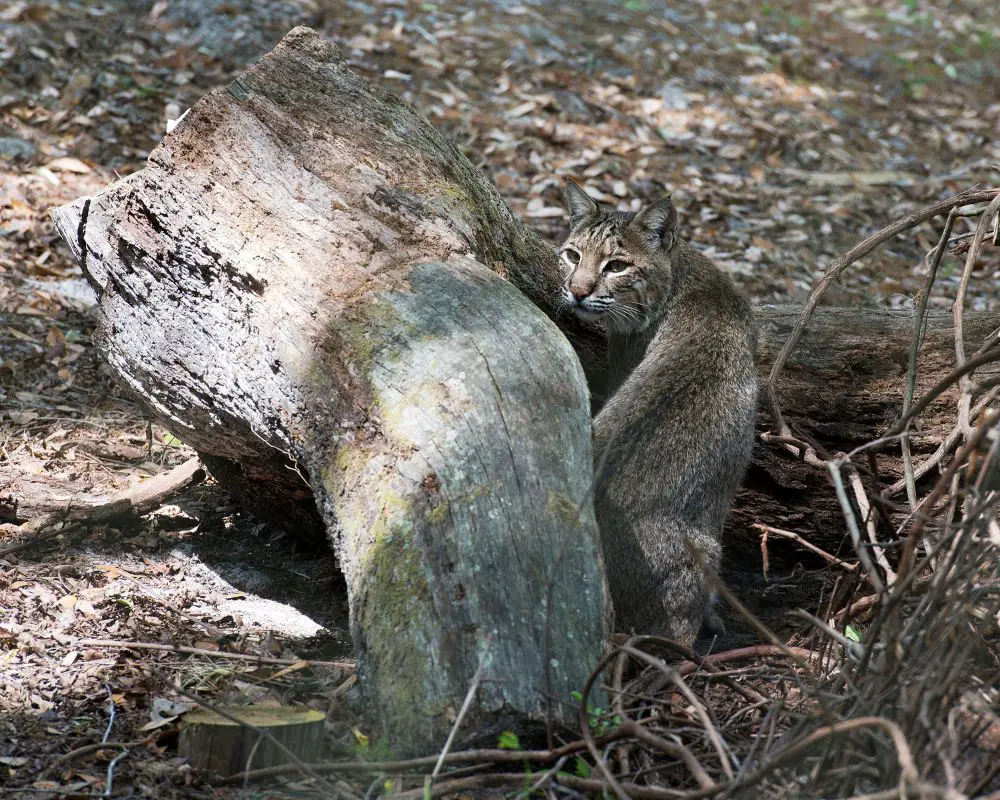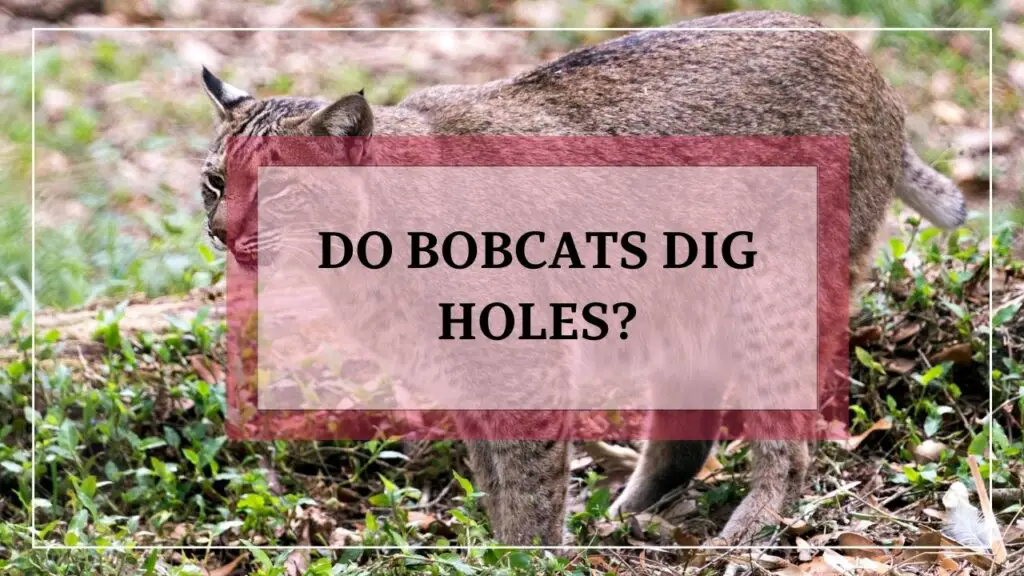Bobcats are solitary animals that are generally active at night, making them difficult to observe in the wild. They are important components of many ecosystems, and their behavior can have significant impacts on their surroundings.
It is important to understand the habits and behaviors of these animals in order to manage their populations and prevent conflicts with humans. One aspect of bobcat behavior that is often of interest is digging holes.
In this article, we will explore whether bobcats dig holes or not. We will also take a close look at why bobcats dig holes and the effects of these activities on the landscape and wildlife.
Do Bobcats Dig Holes?
Yes, bobcats do dig holes. Bobcats are carnivorous predators and are known to dig holes to create dens for resting, hiding, and raising their young.
They usually dig their dens in areas with soft soil, such as under bushes or trees, or near rocky outcroppings. Bobcats are also known to use their sharp claws to dig out burrows created by other animals, such as ground squirrels, and convert them into their dens.
Bobcats will also dig holes to bury their prey, such as rabbits or squirrels, which they can return to and feed on later. This behavior helps to protect their food source from being scavenged by other animals. Additionally, digging holes provides bobcats with a way to escape from danger and hide from predators, as they are quick and agile diggers.
What Do Bobcats Dig Holes For?

Here are some of the reasons we know that justify why bobcats dig holes:
1. Nesting And Raising Young
Bobcats often dig holes as a place to raise their young. The holes provide shelter and protection for the kittens, and the surrounding vegetation can be used for cover and hunting.
2. Storing Food
Bobcats may also dig holes to store their prey, such as small mammals or birds, to eat later. By burying their food, bobcats can prevent it from being taken by other animals or from being exposed to the elements.
3. Marking Territory
Bobcats also use digging as a way to mark their territory. By digging holes and leaving scent markers, bobcats can communicate with other bobcats about their presence in a particular area.
Characteristics of Bobcat Holes
You probably need to know the shape of bobcat holes. Why? Because you really need to identify them once you see them in order to protect yourself from the upcoming dangers caused by them. Here are some of the popular characteristics of their holes:
1. Size And Shape
Bobcat holes are typically small, measuring between 6 and 12 inches in diameter. They are typically circular or oval in shape and may be deeper or shallower depending on the purpose of the hole.
2. Location
Bobcats typically dig holes in areas with loose soil, such as sand or soil mixed with organic material. They may also dig holes in rocky areas or near vegetation.
3. Presence Of Tracks And Scat
The presence of bobcat tracks and scat near a hole can indicate that the hole was dug by a bobcat. The tracks may show the paw prints of the bobcat and any prey it was carrying, and the scat may contain the remains of the bobcat’s meals.
Effects of Bobcat Holes on Landscape and Wildlife
Now, let’s dig deeper into how these holes affect nature:
1. Positive Impacts
Bobcat holes can provide a habitat for small mammals and reptiles, as well as insects and other invertebrates. They may also help to aerate the soil and promote plant growth.
2. Negative Impacts
Bobcat holes can also be a potential hazard for humans and domestic animals. They may cause injury if someone or an animal step in one, and they can also provide hiding places for venomous snakes.
3. Importance Of Balancing Human And Wildlife Interests
It is important to balance the benefits and drawbacks of bobcat holes in order to promote a healthy and sustainable relationship between humans and wildlife. This may involve limiting the expansion of bobcat populations in areas where they pose a significant risk to human safety or property while protecting and preserving their habitats in other areas.
Preventing Conflicts with Bobcats
As you may know, having a bobcat near you isn’t the safest thing to do. Here are some ways that we help you reduce the risk of conflicts with bobcats:
Tips For Reducing Attractants
To prevent conflicts with bobcats, it is important to reduce the attractants that may attract them to your property. This may include removing sources of food, such as outdoor pet food and fallen fruit, and securing trash cans.
Importance Of Keeping Domestic Pets Safe
It is also important to keep domestic pets, such as cats and dogs, safe from bobcats. This may involve keeping pets indoors or supervising them when they are outside, and installing fencing or other barriers to keep bobcats away from your property.
Understanding Bobcat Behavior And Habits
Finally, understanding the behavior and habits of bobcats can help you prevent conflicts with these animals. By knowing when and where bobcats are most active, and what activities they are most likely to engage in, you can better prepare for and manage encounters with these fascinating animals.
FAQs
Do Bobcats Dig Under Fences?
Yes, bobcats can dig under fences. Bobcats are known for their agility and strong digging abilities, and they will often dig under fences to gain access to food or to escape from danger. If a bobcat is motivated to get to the other side of a fence, it may use its sharp claws to dig a hole under the fence and slip through. This can be especially problematic for those who have livestock or pets that they are trying to keep safe from predators.
It’s important to note that bobcats are usually shy and will avoid people if given the chance. However, if they are cornered or threatened, they can become dangerous and aggressive. Therefore, it’s important to take steps to keep them away from your property, such as maintaining a secure fence and keeping pets indoors at night.
To prevent bobcats from digging under fences, it is recommended to bury the bottom of the fence at least 12 inches below ground level or to install a barrier, such as a metal sheet or mesh, at the bottom of the fence to deter digging. Additionally, removing nearby food sources, such as bird feeders or outdoor pet food, can also discourage bobcats from visiting the area.
Do Bobcats Dig Burrows?
Bobcats do not typically dig burrows. Bobcats are solitary animals that create dens for resting, hiding, and raising their young, but they do not typically dig burrows like some other species, such as rabbits or groundhogs.
Instead, bobcats tend to make use of existing dens, such as those created by other animals, or they may dig shallow holes or dens under bushes or trees, or near rocky outcroppings. In these dens, bobcats will typically make a bed of leaves, twigs, and grass to create a comfortable place to rest and sleep. In some cases, bobcats will also use their dens to store food, such as prey that they have caught and wish to eat later.
What Does A Bobcat Den Look Like?
A bobcat den typically looks like a small, shallow hole or a depression in the ground, covered with leaves, twigs, and grass to create a bed. The den may be located under a bush or tree, near a rocky outcropping, or in a hollowed-out log or other natural cavities. Bobcats may also use existing dens created by other animals, such as ground squirrels or skunks, and may modify these dens to suit their needs.
Bobcat dens are usually about 2 to 3 feet in diameter and about 1 to 2 feet deep. The inside of the den will often be lined with soft material to create a comfortable bed, and the entrance to the den may be narrow to provide protection from predators and the elements.
In addition to serving as a place to rest and sleep, bobcat dens may also be used to raise their young. Female bobcats will often give birth to a litter of kittens in the den, and they will remain there to care for and protect the kittens until they are old enough to venture out on their own.

Hi, I’m Ali Tarek, the founder of Animalsman. I’ve always been passionate about pets, especially dogs and cats, and I created this website to share practical tips, easy recipes, and helpful care advice for fellow pet lovers. My goal is to make pet care simple, enjoyable, and accessible for everyone. When I’m not writing or curating content, you’ll usually find me spending time with my furry friends or learning new ways to keep them happy and healthy.



